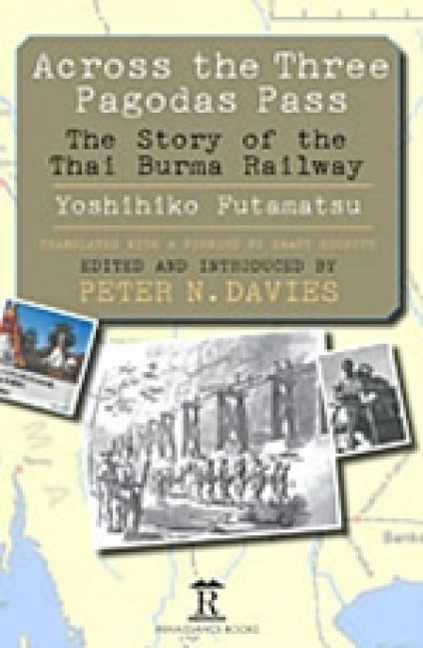Book contents
- Frontmatter
- Dedication
- Contents
- Acknowledgements
- Foreword
- Introduction
- Across the Three Pagodas Pass
- Translator’s Acknowledgements
- Preface
- Chapter 1 Departure for the Front
- Chapter 2 In Indo-China
- Chapter 3 Opening of Hostilities
- Chapter 4 The River Krian
- Chapter 5 The Malayan Campaign
- Chapter 6 The Fall of Singapore
- Chapter 7 Surrender
- Chapter 8 Shōnan: Light of the South
- Chapter 9 The Thai-Burma Railway
- Chapter 10 Preparing Construction
- Chapter 11 Banpong
- Chapter 12 Prisoners-of-War
- Chapter 13 Constructing the Railway
- Chapter 14 Thailand
- Chapter 15 The River Kwae Noi
- Chapter 16 The Mae Khlaung Bridge
- Chapter 17 Kanchanaburi
- Chapter 18 The Jungle
- Chapter 19 From Bangkok to Singapore
- Chapter 20 Rush Construction
- Chapter 21 The Base at Wanyai
- Chapter 22 The Labour Force
- Chapter 23 Survey Unit
- Chapter 24 Test Run
- Chapter 25 Bridge-Building and Shifting Earth
- Chapter 26 The Rainy Season: The Monsoon
- Chapter 27 Kinsaiyok
- Chapter 28 Diseases and Epidemics
- Chapter 29 Cattle Drive
- Chapter 30 Living in the Jungle
- Chapter 31 Soon to the Three Pagodas Pass
- Chapter 32 Towards the Setting Sun
- Chapter 33 Opening to Traffic
- Chapter 34 The Bombing
- Chapter 35 End of the War
- Chapter 36 Internment
- Chapter 37 Repatriation
- Footnote
- Postscript
- End Notes
- Glossary
- Bibliography
- Index
Chapter 6 - The Fall of Singapore
Published online by Cambridge University Press: 13 May 2022
- Frontmatter
- Dedication
- Contents
- Acknowledgements
- Foreword
- Introduction
- Across the Three Pagodas Pass
- Translator’s Acknowledgements
- Preface
- Chapter 1 Departure for the Front
- Chapter 2 In Indo-China
- Chapter 3 Opening of Hostilities
- Chapter 4 The River Krian
- Chapter 5 The Malayan Campaign
- Chapter 6 The Fall of Singapore
- Chapter 7 Surrender
- Chapter 8 Shōnan: Light of the South
- Chapter 9 The Thai-Burma Railway
- Chapter 10 Preparing Construction
- Chapter 11 Banpong
- Chapter 12 Prisoners-of-War
- Chapter 13 Constructing the Railway
- Chapter 14 Thailand
- Chapter 15 The River Kwae Noi
- Chapter 16 The Mae Khlaung Bridge
- Chapter 17 Kanchanaburi
- Chapter 18 The Jungle
- Chapter 19 From Bangkok to Singapore
- Chapter 20 Rush Construction
- Chapter 21 The Base at Wanyai
- Chapter 22 The Labour Force
- Chapter 23 Survey Unit
- Chapter 24 Test Run
- Chapter 25 Bridge-Building and Shifting Earth
- Chapter 26 The Rainy Season: The Monsoon
- Chapter 27 Kinsaiyok
- Chapter 28 Diseases and Epidemics
- Chapter 29 Cattle Drive
- Chapter 30 Living in the Jungle
- Chapter 31 Soon to the Three Pagodas Pass
- Chapter 32 Towards the Setting Sun
- Chapter 33 Opening to Traffic
- Chapter 34 The Bombing
- Chapter 35 End of the War
- Chapter 36 Internment
- Chapter 37 Repatriation
- Footnote
- Postscript
- End Notes
- Glossary
- Bibliography
- Index
Summary
In the early hours of 8 February 1942 the Japanese Army's 5 and 18 divisions, who had been awaiting their opportunity to invade the Island's North coast by The Straits at Johore, crossed The Straits in the dark in small boats and made a decisive landing in the face of the enemy, a landing achieved bit-by-bit under enemy shell-fire. The Straits echoed with their voices encouraging one another. Their campaign to take Singapore Island was beginning.
The surviving British, Indian and Australians were now all on the Island, and the GOC commanding its defence, Lt-General Percival, had been strengthening its defence-works, but part of the British 18 Division reinforcement had still not arrived. The Island had lost mastery of the air and day-after-day the streets of the City were exposed to bombing, bombing on streets which sustained damage and had no military equipment.
An officer of a British reinforcement group landed on the Island on 5 February. His company was in the supply and barracks corps (the Royal Army Service Corps). He was Lieutenant Geoffrey Pharaoh Adams, and in his book, No Time for Geishas (1973) he tries to recount how it happened. I quote from it:
In February 1942 we were approaching Singapore in our transport. Lying off Cape Town in South Africa we had heard that two British battleships had been sunk. The ship altered what had so far been her course and we proceeded in haste to Singapore. I am a butcher's son, volunteered for the Army, became a lieutenant and because of my trade was posted to the Royal Army Service Corps. When we left England in December 1941 America was a neutral power vis-à-vis the war with Germany, but on 8 December when Japan started the Pacific War the joint Allied Forces group was formed. At this point my first acquaintance with Singapore came into my thoughts and I knew nothing of the fighting in Malaya, so I could guess what might happen when we reached the Island a few days before the Japanese Army landed on it.
- Type
- Chapter
- Information
- Across the Three Pagodas PassThe Story of the Thai-Burma Railway, pp. 18 - 23Publisher: Amsterdam University PressPrint publication year: 2013



